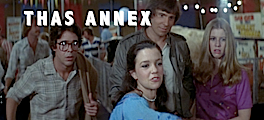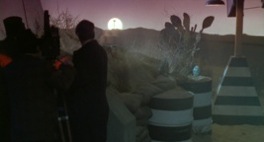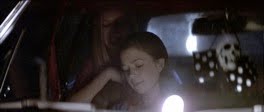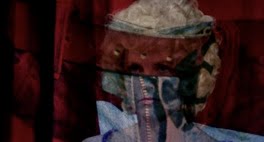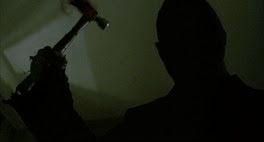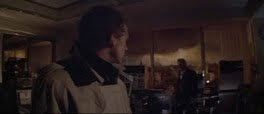The point being, the state of one's central nervous system is for the most part inaccessible to the outside observer, and it tends to present more aberration and individuation than it does systematization. Argento seems in good health, yet he's inflicted us with Mother of Tears. Craven seems to be getting younger as the years pass! But there's undeniable logic when mapping the passing of time and era to the creative output of the aging artist. For the Golden Age horror auteur, this seems to be a more-rapid-than-most decline into senility. Nevertheless, taking into account the slowing processes, or the endocrinal shock that is the movie-making industry (or, their own career) deforming before their very eyes, is always helpful when showing them much-deserved leniency for the deficiencies of their most recent works: Argento has proven himself all he needs to. Craven lives for the improvisation, which is improvement enough.
Tobe Hooper I'll take the leap in saying has changed the least. He's not too embittered. Not too re-energized. Not in some weird, manic autumn stage. His output has been steady and modest, with no huff periods of feigned, me-against-the-world retirement, and he seems happy to take what he can get. He has directed more interim television gigs than I had even suspected, and, accordingly, during his run he never takes more than a year between projects.
It's not surprising, then, that his fresh new comeback feature for the 21st century was a genial selling out to the increasingly post-modern, or geek-modern, horror scene, and a suckered concession to his career often labeled as a schlockmeister and slasher filmmaker: 2004's Toolbox Murders is a remake of the remake craze, a studio cash-in on the kitsch of lurid independent 70s grindhouse, a property-entitled commission job on a title of lurid 70s grindhouse, and a horror-nerd-baiting in-joke regarding deadly handyman apparatuses. It's also Hooper's first stupid slasher movie.
Thankfully, Toolbox Murders is studded with the sort of sweetly composed cinematic gilding that characterizes Hooper's best work, and, if that doesn't go very far in instilling a bit of consequence to the film, then at least the thing is brisk and painless with its quick glaze of exquisiteness - a vaguely giallo-esque romp and a throwaway gore & pain flick made for loyal Fangoria readers, but one which nevertheless seems of little intention to fostering sickly-sensational slasher misanthropy or general miserableness. The screenplay is much too amiable, consisting of an actual storyline hinging on the exploits of a plucky heroine (played by spunky Angela Bettis), and Hooper's camera much too in typical Hooper form: fancy, alive, ornate.
Hooper is rarely aided by the auspices of A-class material. This is partly a natural extension of Hooper's project choices, itself a reflection of his more modest, or lacking, intellectual imperatives and "intellectual command" (usually the thing we're used to seeing in most great auteurs). But this lack is also a testament to Hooper's gently loftier artistic principles, which locate themselves in the smaller and more minute. In contrast to the command certain great directors have over their work, germinated from an origin of a good screenplay or a grand vision of image and sound, Hooper's particular specialness is more in the tradition of the intimate, moment-to-moment expressiveness of a theater-director-turned-filmmaker, spinning cinematic gold from material not already imposingly cinematic. (I've come up with a certain comparison for Hooper, as being more of an Ingmar Bergman-without-the-commensurateness, as opposed to, say, a Stanley Kubrick, without-the-intellectuality.)
The thing about Hooper's work, including Toolbox Murders, is that every second to every shot seems pored over with a picky eye and an insistence on cinematographic floridness. Moment after moment is treated with the finest of brush strokes, ones which prove not only vibrantly ornamental but tied to a presentational rhetoric of emotional intimacies, the soulful presence of an empathic camera, and the elation of form itself - staging, mise en scene, textural complexity, and the sequence thereof, structured and unspooling with the timing and light-footedness of a beautiful dance, song, poem.
While most of the greatest directors have some sense of the minute composition, I am more and more convinced Hooper has one of the most elegantly anti-opportunistic, crisply intricate, complexly abstract, personally far-reaching, and sincerely far-felt instincts for this (which makes it seem not enough to merely label him a "stylist"). And so the relief created from how lacking and without guidance his material is, with yet the amount of exactitude and sublimity Hooper still brings out with the very minuteness of directing and directing alone (directing being the mapping and guidance of actor and camera, with use of everything from the cinematography to its mise en scene, from actors' staging to their physiognomy) is what makes me marvel at Hooper as one of cinema's purest aesthetes.
The momentary elegances of Toolbox Murders, though, are constantly half-cocked, symptomatic of a film not borne from serious artistic intention or thematic impetus. Meaningfulness is lost in the film's overriding origin from commercial formula and self-defeating genre inanity, and Hooper does not make any effort to actually change the make-up of a dimensionless, plain-as-clockwork screenplay. Mood seems dictated purely by the conventions of the slasher film, and the eccentric, colorful tonal work Hooper injects into his other films has no outlet in this uniformly generic material. Hooper's only outlet is in the film's comic element, which while enlivening and spirited for the most part, also too often tips into the realm of the "dorky," deflating the gravitas Hooper and co. already have to put increased effort into creating. In compensation, though, the film does boast a satisfactory momentum and forward drive, a nicely plotted series of troubling circumstances and peppy investigative initiative all building up to a final act that provides the needed hellish barrage of frenzied thrills and nightmarish imagery, if little in the way of logic and narrative pay-offs. Toolbox Murders may have one of the most half-written scripts I've ever seen filmed, boasting mumbled exposition about spells that explains nothing, a benevolent old man character (played by Rance Howard, veteran actor and Howard-line progenitor) whose mysterious knowledge is never explained (apparently he's supposed to be a ghost), and a thematic undercurrent about grappling against death (dead fathers, a ghostly old Hollywood star, a killer stubbornly refusing death, a coffin baby who climbed out of his dead mother's womb, etc.) that is only scattered unsatisfactorily via the anemic screenplay.
It is veritably true what I said, that Hooper works with what he gets... but so, Toolbox Murders still has much to admire in the moment to moment. If Hooper has always been incapable of commanding his projects from germination and on into something of unfailing intelligence and polish, he still works dazzling wonders with the sweated "small stuff" - that is, that which is left to that mind's eye camera of his. Analogously, Toolbox Murders is a paycheck film, one in which achieving illustriousness (or truly channeling his poetic sensibilities) would require nothing less than a production and conceptual overhaul. Yet he works with the "big" he's given - a Jace Anderson and Adam Gierasch script - because, genially, he had all the willingness to visually heighten this amiable slasher-whodunnit; to elevate this frivolous homage to his "big" image as the Chainsaw slasher guy. And so be it, if not for him, then for me, at least, on the one condition that he, without any irrevocable hindrances*, continued his sublime practice of the sublime small stuff.
* like a regressed moral sense
I will take a look at some of the first scenes of the film, to show that the film starts off in full presentation of Hooper's assured, precise, artful-by-principle craft:
The Ambulance
A moment of awkward stillness and quiet, of perfectly distended length, is given over to watching a pair of paramedics wheel a loaded gurney into the back of an ambulance (all seen from behind a sheet of plastic canvas). After loading it, they themselves jump into the wagon and it starts off. Only after the ambulance has started moving does Sheri Moon Zombie's character burst into the protected enclosure of the newspaper stand, the briskness of her movement matched to the briskness of the ambulance's departure.
Inside the Newspaper Stand
A swift pan over with Moon to the cashier's stand begins the scene, just as a swift pan with Moon away from the cashier's stand ends the scene:
The Opening-Umbrella Vista
The Off-Screen Street
Water is splashed onto Moon by a passing car - a car and a street that is kept entirely off-screen. Like many of Hooper's other artistic choices, it's not entirely free of Hooper's tin-ear (tin-eye) for tackiness, but it's nevertheless a risky, rigorous sculpting of cinematic space that effectively establishes the film's baroquely smaller scale - the Lusman Arms Hotel (which Moon is walking towards, and is the main setting of the film) as a sort of uncanny Twilight Zone; a death-trap dollhouse cut off from the rest of the world by the thin veil of being either beyond or within the mere line of the frame. Toolbox Murders is in the vein of Hooper's other slasher films in their creation of a space not far off from an alternate reality, in which all the murder and mayhem occur.
Inside the Lusman Arms
We are introduced to the friendly lobby of the Lusman Arms - manned by its two main employees, Ned the repairman and Luis the doorman - through three careful shots of precise survey and movement:
As Sheri Moon's character (Daisy) pushes at the front door buzzer to be allowed into the hotel, Hooper cuts to the inside, where we are introduced to the two employees of the Lusman Arms by way of one of Hooper's fancy multi-orbital shots. A splendidly old-fashioned flourish, we are introduced to Luis the doorman not with his actual self but through the paint cans he carries: the camera tracks upward with the paint cans as Luis carries them off and finally away from the camera.
Only after he moves away are we revealed a ladder and the 2nd employee, Ned, preparing to climb it.
The camera stops and proceeds to track laterally, creating an orbit with the ladder in order to continue observing Luis, who has heard the front buzzer and pushes the release button on his way to bringing the paint cans to their destination.
Luis and Ned's faces are kept obscured, evoking a naturalistic sense of activity, not done for the camera.
(Notice we catch Luis bringing the cans he was previously carrying to their intended destination, Hooper's staging and sequence a means towards a sublime sense of continuity.)
Perhaps I am easily impressed. But I do find so much impressive about this panning shot that makes up (2). The movement of the camera entwined with the movement of Daisy and Luis is graceful and dynamic: the way Daisy is made to pass behind Luis so that his passing in front of her later in the shot creates that sense of entwining movement; how all the while, the still-faceless Ned and the ladder-as-obelisk exist in the foreground as some sort of mysterious reference point; how Luis ends up following Daisy when at first it seemed like he was going to walk forward and behind the ladder; how, when he eventually crosses in front of her, he continues to talk to her, his arm, in gesturing to her, being made to poke into the frame since the camera has already stopped its pan and he has exited off to the side of it.
What we have with these three shots is a mapping of Luis's "toiling," so to speak, over these random cans of paint, going from a point A, to a point B, to a point C (this is much similar in technique to the mapping of the flight of the Lin Sue character in "Scene from The Mangler #1"). Hooper has mapped and structured the camera angles in conjunction with this, and the addition of Daisy entering brings to his composition its purpose, that of perceptiveness to interaction, to the personal spheres of individuals, to the fleeting moments we grant each other with, etcetera and so forth.
Bloody Los AngelesScreen caps at the THAS ANNEX
I've talked about Hooper shining when it comes to staging and emotional acuity but not having enough of a capacity for those big, heady conceptualizations, fool-proof by the virtue of the idea and the genius simplicity. I imagine this moment read like this in the screenplay: "The woman's blood SPLATTERS in gruesome spray onto the window. Through the gore-stained window, we slowly make out the teeming movements and lights of the LA streets, now doused in the COLOR RED." Allow me to *slow clap*. Whether Hooper came up with this moment, or the screenwriters did, or whoever, this "bloody window" bit is a slick idea executed beautifully. The gore-stained window mixes with the lights of the city outside it and combine to create a stained-glass nightmare; a rack focus then reveals the ant-like city and moving headlights behind, now clear but still doused in the color of red.
The shot is held for a perfect amount of time - a little longer than what would be conventionally necessary - before cutting abruptly to:
Introducing Nell & Steven
An undeniably elegant moment introducing the protagonist Nell. The camera tracks slowly into her, soaking in her visible displeasure. Steven, her husband, then enters, a faceless figure and shadowy shape moving past her (his shadow eclipsing her for a brief moment) and entering the foreground.
In the last shot above, Steven, in silhouette, has dropped the box and is caught falling backwards, in the act of seating himself across from Nell. That last shot immediately cuts from there to this:
Notice that Nell's shoulder is in the first screen cap. This is because the camera is doing a swift pan-in towards Steven as he seats himself, one which starts from behind Nell's shoulder and flies in past it. This moving shot interlocks in vivid rhythm with its conjoining shot, matched to the motion of Steven's act of sitting. This is a small but epitomizing example of what I've often called Hooper's "sense of rhyme."
REVIEWS:
Kindertrauma on TOOLBOX MURDERS
Slant on TOOLBOX MURDERS
Inside the Newspaper Stand
A swift pan over with Moon to the cashier's stand begins the scene, just as a swift pan with Moon away from the cashier's stand ends the scene:
The Opening-Umbrella Vista
The Off-Screen Street
Water is splashed onto Moon by a passing car - a car and a street that is kept entirely off-screen. Like many of Hooper's other artistic choices, it's not entirely free of Hooper's tin-ear (tin-eye) for tackiness, but it's nevertheless a risky, rigorous sculpting of cinematic space that effectively establishes the film's baroquely smaller scale - the Lusman Arms Hotel (which Moon is walking towards, and is the main setting of the film) as a sort of uncanny Twilight Zone; a death-trap dollhouse cut off from the rest of the world by the thin veil of being either beyond or within the mere line of the frame. Toolbox Murders is in the vein of Hooper's other slasher films in their creation of a space not far off from an alternate reality, in which all the murder and mayhem occur.
Inside the Lusman Arms
We are introduced to the friendly lobby of the Lusman Arms - manned by its two main employees, Ned the repairman and Luis the doorman - through three careful shots of precise survey and movement:
As Sheri Moon's character (Daisy) pushes at the front door buzzer to be allowed into the hotel, Hooper cuts to the inside, where we are introduced to the two employees of the Lusman Arms by way of one of Hooper's fancy multi-orbital shots. A splendidly old-fashioned flourish, we are introduced to Luis the doorman not with his actual self but through the paint cans he carries: the camera tracks upward with the paint cans as Luis carries them off and finally away from the camera.
Only after he moves away are we revealed a ladder and the 2nd employee, Ned, preparing to climb it.
The camera stops and proceeds to track laterally, creating an orbit with the ladder in order to continue observing Luis, who has heard the front buzzer and pushes the release button on his way to bringing the paint cans to their destination.
Luis and Ned's faces are kept obscured, evoking a naturalistic sense of activity, not done for the camera.
(2)
After a quick cut back to Daisy outside, entering into the building, we cut back inside to the following (the following all one shot):(Notice we catch Luis bringing the cans he was previously carrying to their intended destination, Hooper's staging and sequence a means towards a sublime sense of continuity.)
Perhaps I am easily impressed. But I do find so much impressive about this panning shot that makes up (2). The movement of the camera entwined with the movement of Daisy and Luis is graceful and dynamic: the way Daisy is made to pass behind Luis so that his passing in front of her later in the shot creates that sense of entwining movement; how all the while, the still-faceless Ned and the ladder-as-obelisk exist in the foreground as some sort of mysterious reference point; how Luis ends up following Daisy when at first it seemed like he was going to walk forward and behind the ladder; how, when he eventually crosses in front of her, he continues to talk to her, his arm, in gesturing to her, being made to poke into the frame since the camera has already stopped its pan and he has exited off to the side of it.
(3)
This third shot is the final puzzle piece to closing off the two previous shots. Shot (1) was of Luis working from his back. Shot (2) was of Luis (and Ned) at work from the side. Shot (3) is a shot of Luis at work from his front. One can see it as sort of the peak moment, when we finally have a good look at the friendly man's friendly face (carrying another two paint cans to some destination, again, essentially at some place at the opposite end of the room - to wit, his busy actions don't make much sense, but it goes to show how the motives of it is solely to achieve the effect of intricate blocking). Ned and his ladder-monument remain in the frame, still unrevealed (the scene, again very structurally-minded, ends with finally a clear look of his face).What we have with these three shots is a mapping of Luis's "toiling," so to speak, over these random cans of paint, going from a point A, to a point B, to a point C (this is much similar in technique to the mapping of the flight of the Lin Sue character in "Scene from The Mangler #1"). Hooper has mapped and structured the camera angles in conjunction with this, and the addition of Daisy entering brings to his composition its purpose, that of perceptiveness to interaction, to the personal spheres of individuals, to the fleeting moments we grant each other with, etcetera and so forth.
Bloody Los AngelesScreen caps at the THAS ANNEX
I've talked about Hooper shining when it comes to staging and emotional acuity but not having enough of a capacity for those big, heady conceptualizations, fool-proof by the virtue of the idea and the genius simplicity. I imagine this moment read like this in the screenplay: "The woman's blood SPLATTERS in gruesome spray onto the window. Through the gore-stained window, we slowly make out the teeming movements and lights of the LA streets, now doused in the COLOR RED." Allow me to *slow clap*. Whether Hooper came up with this moment, or the screenwriters did, or whoever, this "bloody window" bit is a slick idea executed beautifully. The gore-stained window mixes with the lights of the city outside it and combine to create a stained-glass nightmare; a rack focus then reveals the ant-like city and moving headlights behind, now clear but still doused in the color of red.
The shot is held for a perfect amount of time - a little longer than what would be conventionally necessary - before cutting abruptly to:
Introducing Nell & Steven
An undeniably elegant moment introducing the protagonist Nell. The camera tracks slowly into her, soaking in her visible displeasure. Steven, her husband, then enters, a faceless figure and shadowy shape moving past her (his shadow eclipsing her for a brief moment) and entering the foreground.
In the last shot above, Steven, in silhouette, has dropped the box and is caught falling backwards, in the act of seating himself across from Nell. That last shot immediately cuts from there to this:
Notice that Nell's shoulder is in the first screen cap. This is because the camera is doing a swift pan-in towards Steven as he seats himself, one which starts from behind Nell's shoulder and flies in past it. This moving shot interlocks in vivid rhythm with its conjoining shot, matched to the motion of Steven's act of sitting. This is a small but epitomizing example of what I've often called Hooper's "sense of rhyme."
REVIEWS:
Kindertrauma on TOOLBOX MURDERS
Slant on TOOLBOX MURDERS

























































